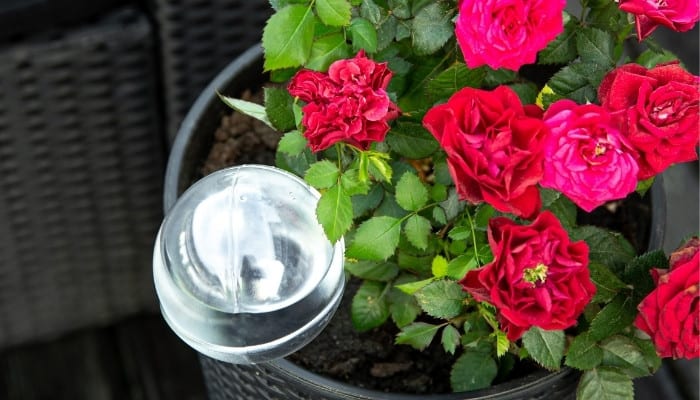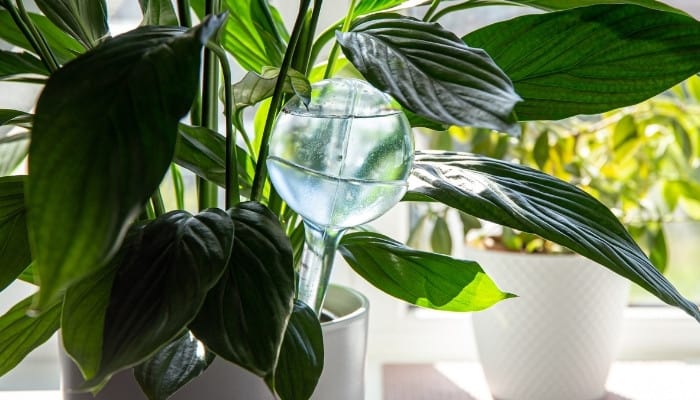You may have noticed watering globes placed in planters and wondered about their function or if they are simply for decoration.
They are pretty as they’re usually made of colorful blown glass that catches your eye as the light changes.
They’re also known as aqua globes or sometimes referred to as watering spikes, though those are a little different.
Which plants like watering globes? Watering globes are a great option for plants that like to maintain moist soil, such as ferns, Calathea, spider plants, pothos, peace lily, Philodendron, elephant ears, and orchids. Watering globes are a great option to keep your plants watered when you are away on vacation.
Watering globes are a typically inexpensive option for maintaining moisture in the soil of your plants. No external water source is needed, and they can add a nice element of decoration to your home.
Understanding how and when to use a watering globe will help prevent any issues.
Watering Globes: How They Work & When To Use Them
Watering globes have a large reservoir on top that holds the water and a thin neck that delivers the water into the soil.
The water is slowly absorbed by the soil, and the thin neck prevents too much water from being released at once.
The most common watering globes are a single piece of blown glass. While these are the most beautiful, they are also the most fragile option.
There are a variety of plastic options that are divided into two pieces: the spike for delivering the water into the soil and the reservoir for holding the water.
Less commonly seen are terra cotta, clay, or metal watering bulbs or spikes.
You can even purchase plastic spikes that attach to the plastic water bottles or glass wine bottles already found in your home.
There are also DIY options using bottles that don’t require any additional purchases.
How Do Plant Watering Globes Work?
Watering globes work through two different mechanisms. First, the soil creates a partial block at the opening of the neck, which prevents the water from pouring out.
Additionally, the water trying to exit the globe blocks air from entering the globe, creating a vacuum. When the soil is wet at the opening of the globe, there is no air to enter the neck.
When the soil is dry, air enters the neck and releases an equal amount of water into the soil.
Equilibrium is reached when the moisture in the soil prevents air from entering the watering globe until the soil requires more water. Simple, yet brilliant!
How Long Do Self-Watering Globes Last?
There are a few factors that determine how long a self-watering globe will last. These include the amount of moisture already in the soil, the size of the globe, and how heavy of a drinker the plant is.
In general, a full watering globe will last 7-14 days in most planters.
When To Use Watering Globes
Most people use watering globes when they are on vacation or otherwise unable to water their plants at the usual intervals.
Watering globes are also beneficial for plants that like to maintain soil moisture consistently.
Many house plant enthusiasts do not use a watering globe regularly because it does not save time from their usual watering routine.
However, those who frequently neglect to check the moisture level of their plants may fine a watering globe to be quite useful.
How To Use Watering Globes
Start by filling the watering globe 2/3 full of water. This is easier for globes with two pieces as the reservoir can be filled and then connected to the spike.
For glass or one-piece globes, a funnel or spout can make filling the globe easier.
Make sure the soil of the plant is already moist. Dry soil will instantly absorb large amounts of water and the watering globe will not last as long.
To insert the globe, start by using a long object (similar in size and shape to the spike or neck of the globe) to create an indentation in the soil. This helps prevent soil from clogging the opening to the globe.
You will need to play around with the angle of the watering globe based on your plant’s needs and how long you want the globe to last.
A completely vertical globe will release water slower than one inserted at a slight angle.
Once the globe has emptied, it may need to be cleaned to remove any debris. If your globe did not come with a cleaning tool, use a pipe cleaner to clean out the delicate neck.
Plants That Benefit From Watering Globes
For vacation usage, almost all plants will benefit from a watering globe when compared to not being watered for 1-2 weeks.
However, long-term usage should be reserved for plants that enjoy having continuously moist soil.
Also, larger plants, like fiddle leaf fig trees or bird of paradise plants, may require more water than the watering globe can provide.
Heavy drinkers, like begonias (check out the gorgeous polka dot begonia here) and African violets, are also likely to use more water than the watering globe can provide.
Another group of plants that will not benefit from watering globes are succulents. Succulents and cacti prefer to have their soil dry out between waterings.
Here are some common plants that will do well with a watering globe:
- Ferns
- Calatheas
- Pitcher plants
- Spider plants
- Pothos
- Peace lily
- Philodendrons
- Ivy
- Elephant ears
- Orchids
Recommended Watering Globes
Cotswold Homecare Watering Globes
These beautiful hand-blown glass watering globes are the perfect size and are quite pretty too.
The large size includes a long neck, allowing the globe to deliver water deep in the soil where your plant’s roots need it.
This set comes with four large globes in different colors: green, teal, royal blue, and red. In addition to the globes, this set includes a free moisture and pH sensor to up your plant care.
GoodMind Creations Improved Watering Globes
This set fixes the problem of soil clogging up the opening of the globe. These glass globes are placed into a plastic tube that remains in the soil.
After using the provided tool to puncture a hole in the plastic tube, you can skip all the cleaning and just enjoy the convenience of self-watering.
The bulbs come in four eye-catching colors: yellow, green, purple, and multicolor. This set also includes a small funnel, making it easier to fill the globes.
Blazin’ Bison Small Watering Globes
This product offers two packages. You can order a set of two large globes or four small bulbs.
The large bulbs are a foot long and perfect for medium-sized planters. The smaller bulbs are just as pretty and a great option for regular use in smaller houseplants.
Can Watering Globes Overwater?
The vacuum created by watering globes prevents overwatering. However, if there is a crack or puncture in your globe, it is possible for the vacuum to be broken and too much water to be released.
Are Glass or Plastic Watering Globes Better?
The material of the watering globe does not matter as long as it does the job for you. Glass globes tend to be more attractive and are made of a more eco-friendly material.
However, if you have rambunctious children or pets, plastic globes are a more durable option.
Do Self-Watering Globes Cause Root Rot?

Since self-watering globes prevent overwatering, they do not cause root rot for most plants. However, plants that are light drinkers might not absorb the water released quickly enough.
This causes the water to sit in the soil for too long and can provide an environment for bacterial or fungal infections.
If you only use watering globes for long vacations, you don’t need to worry about root rot. This period of time will not be long enough to leave too much water in the soil.
Once you return to your normal watering schedule, everything will be fine.
Are Watering Globes Good for Succulents?
Watering globes are not recommended for succulents. The globes maintain the moisture in the soil, and succulents prefer to have the soil dry out between waterings.
In addition, most succulents are fine going without water for an extended period, so they will not benefit from a watering globe.
Are Watering Globes Good for All Plants?
Watering globes are good for keeping plants watered during vacations or for plants that enjoy continuously moist soil.
Plants that prefer to have their soil dry out between waterings or plants that drink large amounts of water are not suited for self-watering globes.
Can Watering Globes Be Used on Outdoor Plants?
Watering globes can be used in outdoor container gardens.
Putting a watering globe into the ground will not be effective because the water will just disperse into the surrounding soil and a vacuum will never be achieved.
Glass is not recommended for outdoor use unless it is in a protected and shaded location, like on a porch. The sun can heat up the glass and the water causing it to break or burn the plant.
Watering Globes vs. Watering Spikes
A watering spike is the equivalent to the neck portion of a watering globe. They operate the same way, but a watering spike will have a detachable reservoir for holding the water.
The spikes will either come with a reservoir or you will attach it to a water or wine bottle.
Watering spikes can come in a variety of materials. Plastic is the most common and cost-effective, but you can also purchase clay or metal spikes.
Are Watering Globes Bad for Plants?
Watering globes are not bad for most plants. They can be beneficial for vacation usage and for plants that enjoy constant moisture in the soil.
Plants that like to dry out between waterings will not do well with the constant flow of water provided by the watering globe.
How To Make Homemade Plant Watering Globes
You can create a watering globe at home using a plastic water bottle or a wine bottle (with a screw-on cap). Use a hammer and nail to puncture one or multiple small holes into the cap of the bottle.
Fill the bottle with water and screw on the lid.
Place the bottle cap side down into the soil. You may need to dig out a small hole for larger bottles to sit in. The same vacuum will be achieved as with the watering globes.
Final Thoughts
Watering globes, or your homemade DIY version, are a great tool to have for longer vacations (and for those who often forget to water!).
No one wants to come home from a fantastic trip only to find their plants sad and wilted. Those persnickety plants that like to be watered every other day will also benefit from the continuous watering.

